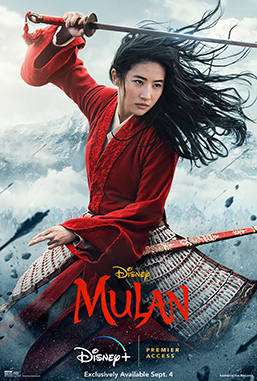Finding Our True Reflection in Disney’s Mulan

February 11, 2021
The audience feels captivated by the movie screen as a young woman lifts a shining sword and dramatically chops off her long dark hair. Mulan, originally released in 1998, has since then changed the world and has had a profound effect on young girls worldwide.
In the original movie, Mulan (voiced by Ming-Na Wen) saves her ill father from serving in the Imperial Army. Aided by her fictional guardian dragon, Mushu (Eddie Murphy) and lucky cricket, she dresses up in men’s military clothing and goes to battle the Northern invaders in China. It is difficult for her at first, and Li Shang (BD Wong) , the son of the army general, trains her and the other troops tirelessly. But along the way she finds that she is competent at anything she puts her mind to, and fights equally, daresay more powerfully, than any of the males in her rank. Laced with enjoyable songs that repeat endlessly in your head like “I’ll Make a Man Out of You,” or ones that deeply move and empower you like “Reflection,” the original 1998 had us all wanting more.
Ever since Disney announced the live-action adaptation of Mulan, it was highly anticipated—although it was robbed of the red carpeted opening that it deserved due to COVID-19. Mulan the live action came out on September 4, 2020, but it was streamed exclusively on Disney+ for subscribers who paid an additional $29.99 fee, creating a virtual theatre-like experience. On December 4th, 2020, it was finally made available to the masses, and many true fans flocked to see it.
Coming with preconceived notions that it wouldn’t be as good as the original (which was a 10/10 in my opinion), I was shocked with the beautiful cinematography and the emotion in the scenes. Although there are no songs to sing along with, the empowerment Mulan (Liu Yifei) brings is still the same, and you fall in love with her again. Many are opposed to the seriousness the live action movie brings, as the fighting scenes do give us a picture of the true brutality of war, and there still remains many other controversies. There are major differences in plot for there is no talking dragon or lucky cricket. Instead, the amazing female director Niki Caro added a beautifully symbolic Phoenix as the guardian of Mulan.
Old fans were disappointed in realizing the beloved Li Shang was replaced with Honghui (Yoson An), a fellow soldier. Although he is Mulan’s perceived love interest, the directors focused on cultivating more female powers. The biggest alteration for me to see was the addition of a “witch” (Gong Lee). The director brought some fantasy elements to her as well, and as she aided the invaders we see her transforming into a majestic eagle, using cruelly beautiful magic. As the film progresses, we actually realize the witch was simply an outcast to the power structure in society, used by men while she was just trying to pave her own way. She tells Mulan how to harness her inner chi (vital life force) to achieve true power. Quickly she turns from the antagonist into the protagonist. She encourages her to take off her male garments and expose her real identity; only then will she be able to harness her full strength and be true to herself. Mulan, the live action, took a beautiful play out of the women’s empowerment that Mulan showed and transformed it into something real.
While Mulan’s deep filial duty to the father reflected the status of men during her time, Mulan’s heroicness transcended that. Under this patriarchal society where Mulan based their time period, women were still stuck to domestic roles. Most families were even disappointed when they had daughters instead of sons, since daughters couldn’t carry on the bloodline. From that age of history, women were property—demonstrated by practices of foot-binding (a brutal symbol of femininity)—and the only way to honor their family would be going to a matchmaker and getting married. They would be given away just like a prize, like an object. Many women who were proved capable among history were accused of heresy and burned for witchcraft. Culturally, it was dishonorable, or even immoral, to consider a woman as capable of fighting in a war. Some of the more frustrating scenes in both the original and adaptation movies depict the male soldiers shunning her and barely sparing her life when they find out she’s a woman, even though she just saved China by tactically defeating the enemy forces.
What it means to really “be a man” is questioned. Since, honestly, Mulan fights harder, smarter, and braver than any of the “real men” in the film. It also broadens upon personal identity, as well as how you value yourself and express it to others, regardless of how other people perceive gender. This idea is welcomed in the 21st century, but not so in ancient China. Therefore, Mulan’s initial popularity would be how it appeals to individuals’ role in society, right?
The original story first appears in The Ballad of Mulan from the Northern Wei Period. The soldiers were shocked when they returned home to realize that they were fighting alongside a woman after all those years. The poem ends with a mention of how no one could tell a female rabbit from a male when the two run side by side; therefore, they are capable of doing things equally when given the opportunity. It’s pure wonder how this poem even gained popularity at that time period when it addressed equality between genders, “Grab a rabbit by its ears / The females squint and the males would kick / While they run loose side-by-side /\/ How could one tell which is it?” (Translation by Thomas Yue).
The poem shows how, even then, ancient China was exploring the theme of gender roles and how a male or female is defined by society. What happens if a person questions a role? These inquiries from the audience further sparked its popularity, as we all have a deep sense of longing to truly understand ourselves and our places in society. This foundational idea and legend has only developed over time into a fully developed cinematic experience of Disney’s Mulan films. Through these films, we acknowledge that gender and one’s identity are not interchangeable, and one cannot define themselves just by ingrained societal systems. This version of Mulan has truly inspired young girls around the world today, especially by showing how we can do anything as equally as competent as males. Women are worth more than their bodies, and what society has labeled for them; they can be just as capable, if not even more capable, than men. Mulan is our weapon to further demonstrate feminism, our badge that we wear proudly. Even when things don’t seem fair, we show our true reflection and fight on.
















































































































































